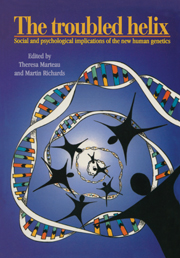Book contents
- Frontmatter
- Contents
- List of contributors
- Preface
- Preface to the paperback edition
- Acknowledgements
- Part I Personal stories
- Part II Clinical context
- Part III Social context
- 9 The troubled helix: legal aspects of the new genetics
- 10 Human pedigree and the ‘best stock’: from eugenics to genetics?
- 11 Public understanding of the new genetics
- 12 Families, kinship and genetics
- 13 Ethics of human genome analysis: some virtues and vices
- 14 Genetics and racism
- 15 Predictive genetics: the cultural implications of supplying probable futures
- 16 The new genetics: a feminist view
- 17 Afterword
- Index
16 - The new genetics: a feminist view
from Part III - Social context
Published online by Cambridge University Press: 01 June 2011
- Frontmatter
- Contents
- List of contributors
- Preface
- Preface to the paperback edition
- Acknowledgements
- Part I Personal stories
- Part II Clinical context
- Part III Social context
- 9 The troubled helix: legal aspects of the new genetics
- 10 Human pedigree and the ‘best stock’: from eugenics to genetics?
- 11 Public understanding of the new genetics
- 12 Families, kinship and genetics
- 13 Ethics of human genome analysis: some virtues and vices
- 14 Genetics and racism
- 15 Predictive genetics: the cultural implications of supplying probable futures
- 16 The new genetics: a feminist view
- 17 Afterword
- Index
Summary
… women… form the central focus of the family-based problems that genetic diseases create. Peter Harper, clinical geneticist, Chapter 1, this volume
Without an awareness of the oneness of things science can give us only nature-in-pieces; more often it gives us only pieces of nature.
Barbara McClintock, cytogeneticist and Nobel prizewinner (quoted in Keller, 1983, p. 205)Introduction
Over the past 25 years the new reproductive technologies (NRTs) such as in vitro fertilisation (IVF) and the new genetics together have aroused my concerns. This may seem odd to molecular biologists, geneticists, embryologists and obstetricians, whose specialisms differ one from the other and who for the most part work independently of each other; but a woman could not help noticing that the first applications of the new genetics impinged on pregnancy and birth – in prenatal screening and the offered abortion for fetuses found to be impaired. This represents a great change from the way in which pregnancy, birth and possible disability were previously understood. Consequent psychological problems for women were likely and seemed obvious. Yet what thought was given to the problems was commonsensical rather than systematic or scientific – and derived from men's, not women's, common sense.
To a sociologist it is axiomatic that a birth is a social as well as a biological event; the arrival of a new member of society changes the social arrangements around it.
- Type
- Chapter
- Information
- The Troubled HelixSocial and Psychological Implications of the New Human Genetics, pp. 331 - 349Publisher: Cambridge University PressPrint publication year: 1996
- 16
- Cited by

